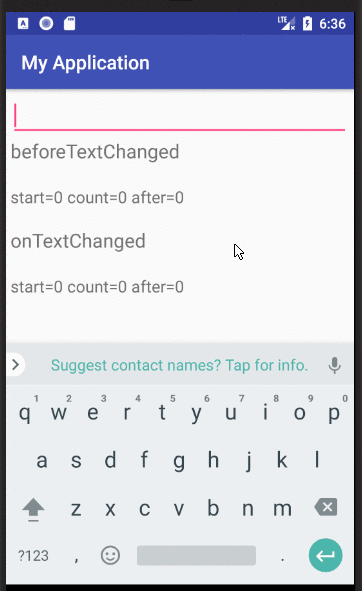Differences between TextWatcher 's onTextChanged, beforeTextChanged and afterTextChanged
Solution 1:
The parameters for beforeTextChanged and onTextChanged are a little hard to understand at first. It may be helpful to see them being used in an example. Watch the following demonstration a few times. Pay attention to the counts.
- The red highlight is the old text that is about to be replaced by the green text.
- The green highlight is the new text that just replaced the red text.

beforeTextChanged
-
startis the start index of the red highlighted text (that is about to be deleted) -
countis the length of the red highlighted text (that is about to be deleted) -
afteris the length of the green highlighted text (that is about to be added)
onTextChanged
-
startis the start index of the green highlighted text (that just got added).
This is the same as thestartofbeforeTextChanged. -
beforeis the length of the red highlighted text (that just got deleted).
This is the same as thecountofbeforeTextChanged. -
countis the length of the green highlighted text (that just got added).
This is the same as theafterofbeforeTextChanged.
afterTextChanged
-
editableis the editable text from the EditText. You are allowed to change it here. Doing so will trigger all theTextWatcherevents again. - You are not given any information about what was changed. If you want to know, you can set a span in
onTextChangedand then look up the span here.
When to use which?
If you want to observe the changes being made, use beforeTextChanged() or onTextChanged(). You are not allowed to change the CharSequence text in either of these methods, though.
If you want to further modify the text after it was changed, do it in afterTextChanged().
Code
Here is the code if you want to play around with it yourself.
MainActivity.java
public class MainActivity extends AppCompatActivity {
final static int RED_COLOR = Color.parseColor("#fb7373");
final static int GREEN_COLOR = Color.parseColor("#40de83");
@Override
protected void onCreate(Bundle savedInstanceState) {
super.onCreate(savedInstanceState);
setContentView(R.layout.activity_main);
EditText editText = findViewById(R.id.editText);
final TextView tvBeforeText = findViewById(R.id.tvBeforeText);
final TextView tvBeforeNumbers = findViewById(R.id.tvBeforeNumbers);
final TextView tvAfterText = findViewById(R.id.tvAfterText);
final TextView tvAfterNumbers = findViewById(R.id.tvAfterNumbers);
editText.addTextChangedListener(new TextWatcher() {
@Override
public void beforeTextChanged(CharSequence s, int start, int count, int after) {
SpannableString spannableString = new SpannableString(s);
BackgroundColorSpan backgroundSpan = new BackgroundColorSpan(RED_COLOR);
spannableString.setSpan(backgroundSpan, start, start + count, Spannable.SPAN_EXCLUSIVE_EXCLUSIVE);
tvBeforeText.setText(spannableString);
tvBeforeNumbers.setText("start=" + start + " count=" + count + " after=" + after);
}
@Override
public void onTextChanged(CharSequence s, int start, int before, int count) {
SpannableString spannableString = new SpannableString(s);
BackgroundColorSpan backgroundSpan = new BackgroundColorSpan(GREEN_COLOR);
spannableString.setSpan(backgroundSpan, start, start + count, Spannable.SPAN_EXCLUSIVE_EXCLUSIVE);
tvAfterText.setText(spannableString);
tvAfterNumbers.setText("start=" + start + " before=" + before + " count=" + count);
}
@Override
public void afterTextChanged(Editable s) {
Log.i("TAG", "afterTextChanged: " + s);
}
});
}
}
activity_main.xml
<?xml version="1.0" encoding="utf-8"?>
<LinearLayout
xmlns:android="http://schemas.android.com/apk/res/android"
android:orientation="vertical"
android:layout_width="match_parent"
android:layout_height="match_parent"
android:padding="5dp">
<EditText
android:id="@+id/editText"
android:layout_width="match_parent"
android:layout_height="wrap_content" />
<TextView
android:layout_width="wrap_content"
android:layout_height="wrap_content"
android:textSize="20sp"
android:text="beforeTextChanged" />
<TextView
android:id="@+id/tvBeforeText"
android:textSize="17sp"
android:layout_width="wrap_content"
android:layout_height="wrap_content" />
<TextView
android:id="@+id/tvBeforeNumbers"
android:textSize="17sp"
android:text="start=0 count=0 after=0"
android:layout_width="wrap_content"
android:layout_height="wrap_content" />
<TextView
android:layout_width="wrap_content"
android:layout_height="wrap_content"
android:textSize="20sp"
android:layout_marginTop="20dp"
android:text="onTextChanged" />
<TextView
android:id="@+id/tvAfterText"
android:textSize="17sp"
android:layout_width="wrap_content"
android:layout_height="wrap_content" />
<TextView
android:id="@+id/tvAfterNumbers"
android:textSize="17sp"
android:text="start=0 count=0 after=0"
android:layout_width="wrap_content"
android:layout_height="wrap_content" />
</LinearLayout>
Solution 2:
onTextChanged runs during the text changing.
afterTextChanged runs immediately after the text is changed.
beforeTextChanged runs the instant before the text is changed.
Depending on when you want to assign variables or do things, you may want to run the code the instant before the change, or the instant after.
Here is an example of this:
String afterTextChanged = "";
String beforeTextChanged = "";
String onTextChanged = "";
@Override
protected void onCreate(Bundle savedInstanceState) {
super.onCreate(savedInstanceState);
setContentView(R.layout.activity_main);
et = (EditText)findViewById(R.id.editText);
et.addTextChangedListener(new TextWatcher() {
@Override
public void onTextChanged(CharSequence s, int st, int b, int c)
{
onTextChanged = et.getText().toString();
}
@Override
public void beforeTextChanged(CharSequence s, int st, int c, int a)
{
beforeTextChanged = et.getText().toString();
}
@Override
public void afterTextChanged(Editable s)
{
afterTextChanged = et.getText().toString();
Toast.makeText(Activity.this, "before: " + beforeTextChanged
+ '\n' + "on: " + onTextChanged
+ '\n' + "after: " + afterTextChanged
,Toast.LENGTH_SHORT).show();
}
});
}
In this case, let's say you changed the text from "h" to "hi", the output would be:
before: "h"
on: "hi"
after: "hi"
Solution 3:
Android TextChangedListener is one kind of trigger which is called on text change of an input field.
TextChangedListener has three events.
1.beforeTextChanged : This means that the characters are about to be replaced with some new text. The text is uneditable. This event is used when you need to take a look at the old text which is about to change.
2.onTextChanged: Changes have been made, some characters have just been replaced. The text is uneditable. This event is used when you need to see which characters in the text are new.
3.afterTextChanged : The same as above, except now the text is editable. This event is used when you need to see and possibly edit new text.
Solution 4:
abstract void afterTextChanged(Editable s)This method is called to notify you that, somewhere within s, the text has been changed.
abstract void beforeTextChanged(CharSequence s, int start, int count, int after)This method is called to notify you that, within s, the count characters beginning at start are about to be replaced by new text with length after.
abstract void onTextChanged(CharSequence s, int start, int before, int count)This method is called to notify you that, within s, the count characters beginning at start have just replaced old text that had length before.
You can more learn here.